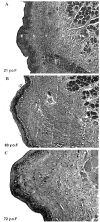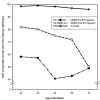Vocal aging and adductor spasmodic dysphonia: response to botulinum toxin injection
- PMID: 18488884
- PMCID: PMC2544359
- DOI: 10.2147/cia.s1416
Vocal aging and adductor spasmodic dysphonia: response to botulinum toxin injection
Abstract
Aging of the larynx is characterized by involutional changes which alter its biomechanical and neural properties and create a biological environment that is different from younger counterparts. Illustrative anatomical examples are presented. This natural, non-disease process appears to set conditions which may influence the effectiveness of botulinum toxin injection and our expectations for its success. Adductor spasmodic dysphonia, a type of laryngeal dystonia, is typically treated using botulinum toxin injections of the vocal folds in order to suppress adductory muscle spasms which are disruptive to production of speech and voice. A few studies have suggested diminished response to treatment in older patients with adductor spasmodic dysphonia. This retrospective study provides a reanalysis of existing pre-to-post treatment data as function of age. Perceptual judgments of speech produced by 42 patients with ADSD were made by two panels of professional listeners with expertise in voice or fluency of speech. Results demonstrate a markedly reduced positive response to botulinum toxin treatment in the older patients. Perceptual findings are further elucidated by means of acoustic spectrography. Literature on vocal aging is reviewed to provide a specific set of biological mechanisms that best account for the observed interaction of botulinum toxin treatment with advancing age.
Figures










References
-
- Ali SO, Thomassen M, Schulz GM, et al. Alterations in CNS activity induced by botulinum toxin treatment in spasmodic dysphonia: an H215O PET study. J Speech Lang Hear Res. 2006;49:1127–46. - PubMed
-
- Amerman JD, Parnell MM. Auditory impressions of the speech of normal elderly adults. Br J Disord Commun. 1990;25:35–43. - PubMed
-
- Aronson AE. Clinical voice disorders. 3. New York: Thieme Medical Publishers; 1990.
-
- Aronson AE, McCaffrey TV, Litchey WJ, et al. Botulinum toxin injection for adductor spasmodic dysphonia: Patient self-ratingof voice and phonatory effort after three successive injections. Laryngoscope. 1993;103:683–91. - PubMed
-
-
Assessment: the clinical usefulness of botulinum toxin-A in treating neurologic disorders. Report of Therapeutics and Technology Assessment Subcommittee of the American Academy of Neurology. 1990.
-
Publication types
MeSH terms
Substances
Grants and funding
LinkOut - more resources
Full Text Sources
Medical

